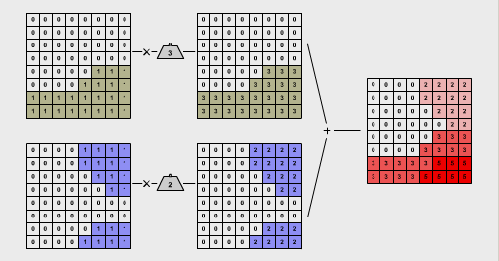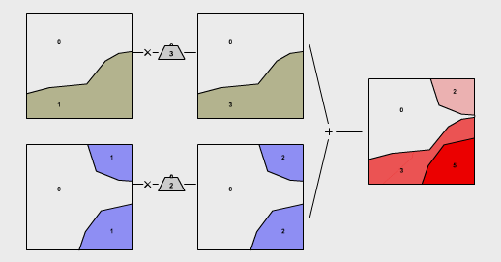|
|
What is a weighted overlay?
In many suitability analyses, some eligibility criteria are more important than others. Often,
it is the expectation in a location search to be able to compare several suitable candidates whether,
and how strongly, they meet a set of criteria of differing importance. By using the layer principle,
one can easily extend the overlay by assigning levels of importance to each criterion.
A numerical weighting factor is assigned to each thematic layer according to its relative importance
compared to all other layers. After that, the weighted layers are overlaid as before. This process is
called ![]() weighted overlay. In principle, weighted overlay is
possible with rasters and vectors just like Boolean overlay. For example, wolf experts in St. Gittal
could explain that the forest, due to its protective nature, is 1.5 times more important for the wolf
than steep and rocky terrain. The corresponding weights would be: weight factor 3 for the forest layer
but only 2 for the terrain layer. It should be noted that value ranges of the input data layers should
correspond to a range between suitable and not suitable (e.g. from 0 to 1). In the resulting suitability
layer, the areas or locations with high values are the most suitable.
weighted overlay. In principle, weighted overlay is
possible with rasters and vectors just like Boolean overlay. For example, wolf experts in St. Gittal
could explain that the forest, due to its protective nature, is 1.5 times more important for the wolf
than steep and rocky terrain. The corresponding weights would be: weight factor 3 for the forest layer
but only 2 for the terrain layer. It should be noted that value ranges of the input data layers should
correspond to a range between suitable and not suitable (e.g. from 0 to 1). In the resulting suitability
layer, the areas or locations with high values are the most suitable.
In this illustration, both suitability criteria for the wolf habitat in St. Gittal were given weights according to their relative importance. The information layer "forested" is weighted by a factor of 3; the layer "steep terrain" by a factor of 2. After assigning weights, the two layers are added. Suitability values for the resulting layer range from 0 (not suitable) to 5 (very suitable).


